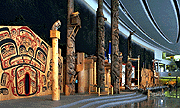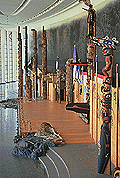Grand Hall tour
Raven's Village

In the philosophy of the people of the coast, a house represents much
more than shelter. It represents the family and the history of the
family, all that the family has been and all it might be in the future.
 The houses in the Grand Hall do not come from a single village, but
represent six different coastal
nations. All the housefront are based on photographs of actual
historic houses found on the coast in the last 150 years, and have been
reconstructed by Native artisans from their respective regions.
The houses in the Grand Hall do not come from a single village, but
represent six different coastal
nations. All the housefront are based on photographs of actual
historic houses found on the coast in the last 150 years, and have been
reconstructed by Native artisans from their respective regions.
The curved lines of the Grand Hall simulate the shape of sheltered bays
and rivers along the Pacific Coast of British Columbia, where traditional
Native villages were located. Villages were often built on narrow coastal
plains only a few steps away from the sea. Many Native people still live
in towns and villages located on or near sites where their ancestors
had lived since time immemorial.
 Alert Bay, ca. 1910; the
Wakas house is on the
right
Alert Bay, ca. 1910; the
Wakas house is on the
right
(National Archives of Canada, C47366)
In a traditional village, houses were built side by side, facing the sea. Society was organized in a highly structured manner; each family and individual had a unique place in the social hierarchy. The largest house, located in the centre of the village, belonged to the highest-ranking chief. The adjacent houses were deliberately placed on the same horizontal line, one next to the other, indicating that these families were related to each other. The houses on each side of the central chief's house belonged to chiefs of lesser rank, in descending order. The families of the lowest-ranking chiefs lived at both ends of the village. (This principle, however, cannot be applied to the houses in the Grand Hall, since each one comes from a different village).
Behind the rain-forest were mountains and rain forests that provided many of the necessities of life, including the mighty cedar. Its strong, light, straight-grained wood is perfect for making totem poles, houses, boxes, bark clothing and many other items.
The people of the coast were seafarers who travelled between villages in their dug-out canoes. The mainstay of their diet was fish, caught using hooks and lines, nets, spears and traps. People also hunted sea mammals, and gathered wild fruits and root vegetables from the land.
